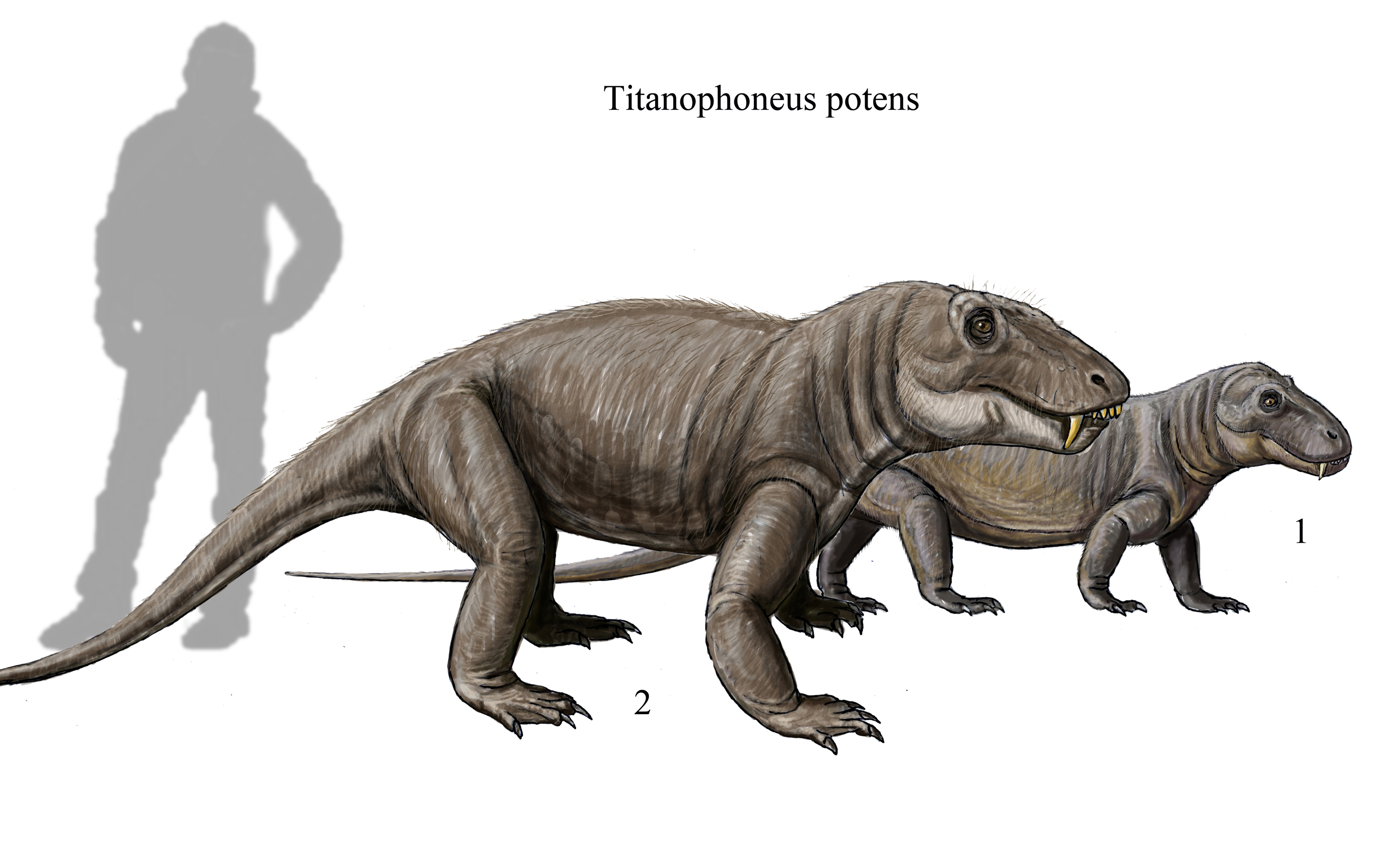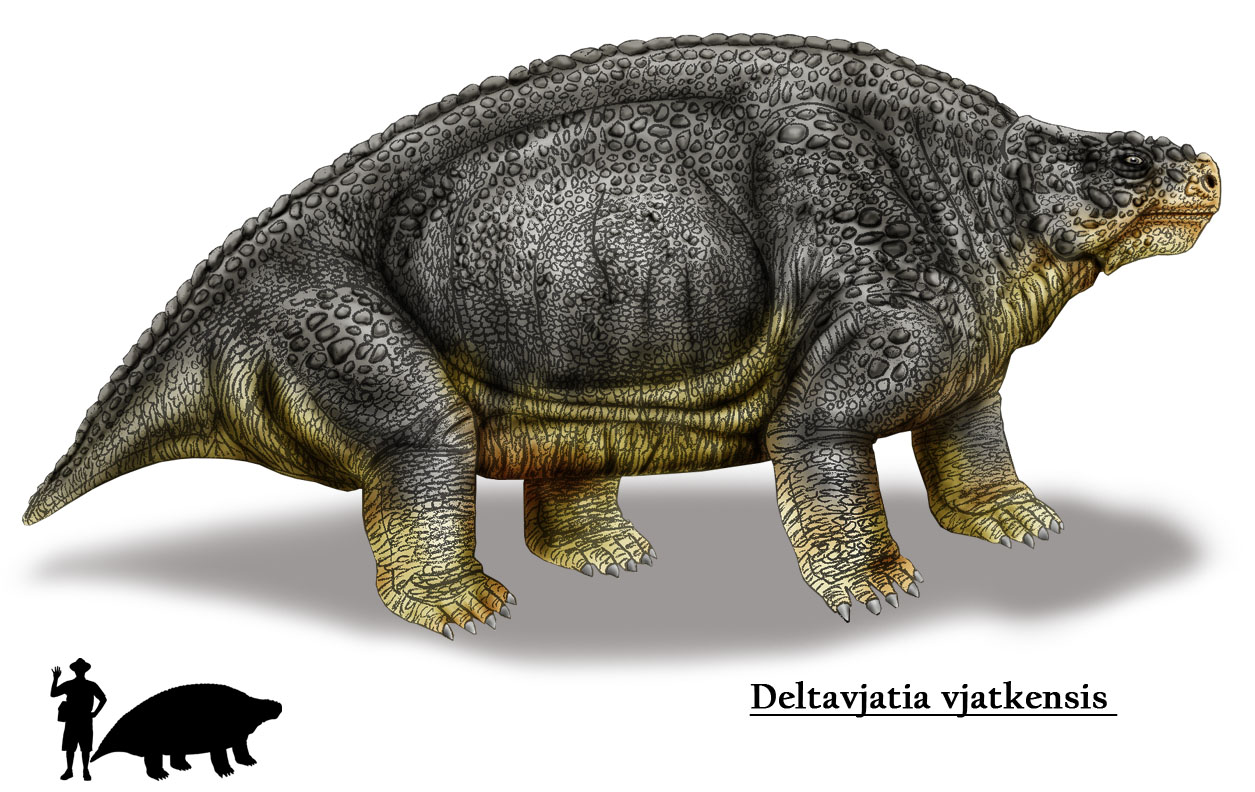|
Perplexisaurus
''Perplexisaurus'' is a genus of therocephalian therapsid from the Middle to Late Permian ''Deltavjatia vjatkensis'' Assemblage Zone, Vanyushonki Member of the Urpalov Formation of Russia. It was described by L. P. Tatarinov in 1997, and the type species is ''P. foveatus''. A new species, ''P. lepusculus'', was described by M.F. Ivachnenko in 2011, from Russia.Ivakhnenko, M.F. (2011). "Permian and Triassic therocephals (Eutherapsida) of Eastern Europe". Paleontological Journal 45 (9): 981–1144. . References External links ''Perplecisaurus''at the Paleobiology Database The Paleobiology Database is an online resource for information on the distribution and classification of fossil animals, plants, and microorganisms. History The Paleobiology Database (PBDB) originated in the NCEAS-funded Phanerozoic Marine Pale ... {{Taxonbar, from=Q1835506 Ictidosuchids Guadalupian synapsids Lopingian synapsids of Europe Fossils of Russia Fossil taxa described in 1997 ... [...More Info...] [...Related Items...] OR: [Wikipedia] [Google] [Baidu] |
2011 In Paleontology
Protozoa New taxa Plants Ferns and fern allies Gymnosperms Gymnosperm research *An amplified whole plant reconstruction of the Ypresian Princeton chert pine '' Pinus arnoldii'', expanding the diagnosis to include ''P. similkameenensis'' (Miller, 1973 Events January * January 1 - The United Kingdom, the Republic of Ireland and Denmark enter the European Economic Community, which later becomes the European Union. * January 15 – Vietnam War: Citing progress in peace negotiations, U.S. ...) foliage and wood plus unnamed pollens cones found in attachment to the ''P. arnoldii'' ovulate cones is published by Klymiuk, Stockey, & Rothwell. Angiosperms Nematoda Lobopods Vetulicolians Molluscs Arthropods Fishes Amphibians Newly named lepospondyls Newly named temnospondyls Newly named lissamphibians Basal reptiles Newly named captorhinids Newly named basal diapsids Newly named ichthyosaurs Lepidosauromorphs Newly named saurosphargids New ... [...More Info...] [...Related Items...] OR: [Wikipedia] [Google] [Baidu] |
Therocephalian
Therocephalia is an extinct suborder of eutheriodont therapsids (mammals and their close relatives) from the Permian and Triassic. The therocephalians ("beast-heads") are named after their large skulls, which, along with the structure of their teeth, suggest that they were carnivores. Like other non-mammalian synapsids, therocephalians were once described as "mammal-like reptiles". Therocephalia is the group most closely related to the cynodonts, which gave rise to the mammals. This relationship takes evidence in a variety of skeletal features. The fossils of therocephalians are numerous in the Karoo of South Africa, but have also been found in Russia, China, Tanzania, Zambia, and Antarctica. Early therocephalian fossils discovered in Middle Permian deposits of South Africa support a Gondwanan origin for the group, which seems to have spread quickly across Earth. Although almost every therocephalian lineage ended during the great Permian–Triassic extinction event, a few represen ... [...More Info...] [...Related Items...] OR: [Wikipedia] [Google] [Baidu] |
Middle Permian
The Guadalupian is the second and middle series/epoch of the Permian. The Guadalupian was preceded by the Cisuralian and followed by the Lopingian. It is named after the Guadalupe Mountains of New Mexico and Texas, and dates between 272.95 ± 0.5 – 259.1 ± 0.4 Mya. The series saw the rise of the therapsids, a minor extinction event called Olson's Extinction and a significant mass extinction called the end-Capitanian extinction event. The Guadalupian was previously known as the Middle Permian. Name and background The Guadalupian is the second and middle series or epoch of the Permian. Previously called Middle Permian, the name of this epoch is part of a revision of Permian stratigraphy for standard global correlation. The name "Guadalupian" was first proposed in the early 1900s, and approved by the International Subcommission on Permian Stratigraphy in 1996. References to the Middle Permian still exist. The Guadalupian was preceded by the Cisuralian and followed by the Lop ... [...More Info...] [...Related Items...] OR: [Wikipedia] [Google] [Baidu] |
Late Permian
Late may refer to: * LATE, an acronym which could stand for: ** Limbic-predominant age-related TDP-43 encephalopathy, a proposed form of dementia ** Local-authority trading enterprise, a New Zealand business law ** Local average treatment effect, a concept in econometrics Music * Late (album), ''Late'' (album), a 2000 album by The 77s * Late!, a pseudonym used by Dave Grohl on his ''Pocketwatch (album), Pocketwatch'' album * Late (rapper), an underground rapper from Wolverhampton * Late (song), "Late" (song), a song by Blue Angel * "Late", a song by Kanye West from ''Late Registration'' Other * Late (Tonga), an uninhabited volcanic island southwest of Vavau in the kingdom of Tonga * Late (The Handmaid's Tale), "Late" (''The Handmaid's Tale''), a television episode * LaTe, Laivateollisuus, Oy Laivateollisuus Ab, a defunct shipbuilding company * Late may refer to a person who is Dead See also * * * ''Lates'', a genus of fish in the lates perch family * Later (other) ... [...More Info...] [...Related Items...] OR: [Wikipedia] [Google] [Baidu] |
1997 In Paleontology
Plants Cycadophytes Cycadophyte research *Hopkins and Johnson briefly report the first occurrence of cycad leaves from the Eocene Okanagan Highlands Klondike Mountain Formation which will later be identified to the family Zamiaceae. Angiosperms Fungi newly named Arthropoda Insects Plesiosaurs Newly Named Plesiosaurs Archosauromorphs Pterosaurs Newly Named Pterosaurs Non-avian dinosauromorphs * Paleontologist Karen Chin received a coprolite that was excavated during 1995 from strata dating back to the Maastrichtian in Saskatchewan, Canada. The specimen was about 17 inches (44 cm) long and contained fragments of bone. Due to its size, contents and age, the coprolite was believed to have been the remains of ''Tyrannosaurus rex'' feces. This discovery was announced in a 1998 paper published in the journal ''Nature''. * A Saharan expedition under the leadership of Paul Sereno yielded fruit when a team member stumbled on the bones and skull of '' Nigersa ... [...More Info...] [...Related Items...] OR: [Wikipedia] [Google] [Baidu] |
Type Species
In zoological nomenclature, a type species (''species typica'') is the species name with which the name of a genus or subgenus is considered to be permanently taxonomically associated, i.e., the species that contains the biological type specimen(s). Article 67.1 A similar concept is used for suprageneric groups and called a type genus. In botanical nomenclature, these terms have no formal standing under the code of nomenclature, but are sometimes borrowed from zoological nomenclature. In botany, the type of a genus name is a specimen (or, rarely, an illustration) which is also the type of a species name. The species name that has that type can also be referred to as the type of the genus name. Names of genus and family ranks, the various subdivisions of those ranks, and some higher-rank names based on genus names, have such types. [...More Info...] [...Related Items...] OR: [Wikipedia] [Google] [Baidu] |
Therapsid
Therapsida is a major group of eupelycosaurian synapsids that includes mammals, their ancestors and relatives. Many of the traits today seen as unique to mammals had their origin within early therapsids, including limbs that were oriented more underneath the body, as opposed to the sprawling posture of many reptiles and salamanders. Therapsids evolved from "pelycosaurs", specifically within the Sphenacodontia, more than 279.5 million years ago. They replaced the "pelycosaurs" as the dominant large land animals in the Middle Permian through to the Early Triassic. In the aftermath of the Permian–Triassic extinction event, therapsids declined in relative importance to the rapidly diversifying reptiles during the Middle Triassic. The therapsids include the cynodonts, the group that gave rise to mammals ( Mammaliaformes) in the Late Triassic, around 225 million years ago. Of the non-mammalian therapsids, only cynodonts survived beyond the end of the Triassic, with the only other ... [...More Info...] [...Related Items...] OR: [Wikipedia] [Google] [Baidu] |
Deltavjatia Vjatkensis Assemblage Zone
''Deltavjatia'' was a pareiasauromorph procolophonoid from the Tatarian stage of the Permian time period. It had a large body of about in length. ''Deltavjatia'' was an herbivore and lived in what is now Russia. The first specimen of ''Deltavjatia'' was a specimen of a skull and lower mandible (PIN 2212/1), found in the Urpalov Formation in Kotelnich, Vyatka River. Since then, numerous mostly complete skeletons have been found, many of them being so well preserved due to the silty, anaerobic environment of the Kotelnich deposits that fossilised white blood cells are able to be distinguished in them. Analyses of the bone histology of ''Deltavjatia'' show that they grew very rapidly during the early stages of their ontogeny but that their growth rate drastically slowed down once they reached approximately half of their full body size. ''Deltavjatia'' was placed as a subtaxon of Pareiasauridae by M.S.Y. Lee in 1997. See also *Pareiasaur *Procolophonia *Kotelnich *Vyatka (river) ... [...More Info...] [...Related Items...] OR: [Wikipedia] [Google] [Baidu] |
Russia
Russia (, , ), or the Russian Federation, is a List of transcontinental countries, transcontinental country spanning Eastern Europe and North Asia, Northern Asia. It is the List of countries and dependencies by area, largest country in the world, with its internationally recognised territory covering , and encompassing one-eighth of Earth's inhabitable landmass. Russia extends across Time in Russia, eleven time zones and shares Borders of Russia, land boundaries with fourteen countries, more than List of countries and territories by land borders, any other country but China. It is the List of countries and dependencies by population, world's ninth-most populous country and List of European countries by population, Europe's most populous country, with a population of 146 million people. The country's capital and List of cities and towns in Russia by population, largest city is Moscow, the List of European cities by population within city limits, largest city entirely within E ... [...More Info...] [...Related Items...] OR: [Wikipedia] [Google] [Baidu] |
Paleobiology Database
The Paleobiology Database is an online resource for information on the distribution and classification of fossil animals, plants, and microorganisms. History The Paleobiology Database (PBDB) originated in the NCEAS-funded Phanerozoic Marine Paleofaunal Database initiative, which operated from August 1998 through August 2000. From 2000 to 2015, PBDB received funding from the National Science Foundation. PBDB also received support form the Australian Research Council. From 2000 to 2010 it was housed at the National Center for Ecological Analysis and Synthesis, a cross-disciplinary research center within the University of California, Santa Barbara. It is currently housed at University of Wisconsin-Madison and overseen by an international committee of major data contributors. The Paleobiology Database works closely with the Neotoma Paleoecology Database, which has a similar intellectual history, but has focused on the Quaternary (with an emphasis on the late Pleistocene and Holocen ... [...More Info...] [...Related Items...] OR: [Wikipedia] [Google] [Baidu] |



_(2).jpg)

